Crematoria
Fire funerals were quite common in ancient times but were banned by the monotheistic religions. Only with increasing population densities, a lack of cemetery space, hygienic concerns, and decreasing influence of religions did cremations make a comeback in the late 1800s. They have been on the rise ever since; see the data prior to World War II for Germany in the chart. When the war broke out, cremations were still rather rare in less-developed Eastern European countries, and were viewed with horror by members of orthodox Christian and Jewish communities. This is the background for many a horror story of former deportees confronted with, and utterly misunderstanding, the presence of crematoria in German wartime camps.
Considering the hygienic disaster common in crowded wartime camps, cremating the victims of those camps was a much better solution than burying them, which would have poisoned the drinking-water supply, thus further aggravating the hygienic situation.
Energetically speaking, the worst way of cremating corpses is on a pyre on the flat ground, because much of the heat gets lost due to radiation and convection. A better way is the incineration in relatively narrow trenches, where the earthen walls retain and reflect heat, and convection losses are limited (this advantage is lost when a pit is much wider than deep). Better still is combustion in so-called field furnaces, built in soil pits with stony walls and a ceiling of rocks. But all these methods are far surpassed by modern cremation furnaces. Such facilities not only reduce heat losses due to convection and radiation by encasing the combustion chamber with insulated material, but most of them also recover heat from the exhaust gases by way of heat exchangers or recuperators. The highest efficiency is reached by continuously operating furnaces used for incinerating animal carcasses and slaughter offal.

Many camps operated by German authorities before and during World War II were equipped with one or more cremation furnaces, usually (but not always) placed in a crematorium. Most of these furnaces followed standard civilian design, although some were trimmed-down, cheaper and less efficient versions.
For that reason, all these furnaces were necessarily designed on the assumption that only one corpse is inserted and cremated at a time, as anything else was illegal, even by the rules promulgated by the SS authorities. Therefore, both the size of the muffle (and its corpse-introduction door) as well as the energy output of the fuel system (oil nozzles or coke hearths) were designed to cremate only one body at a time. Although two adult corpses and, if emaciated, maybe even three of them could be placed in a muffle at once with some skill and effort, such a procedure would have reduced the cremation speed considerably,
as the furnace was not designed to evaporate the body water of several corpses at once. Hence, the muffle temperature would have dropped precipitously. On the other hand, once the body water had evaporated and the corpses started burning, they would have created much more heat and combustion gases than the system was able to handle. For more details on this, see the section “Simultaneous Cremation of Multiple Bodies.”
Civilian Cremations
Cremation experts state that the complete cremation process of a human body in their civilian cremation furnaces takes between two to four hours. (See Kulaszka 2019, pp. 292f.; see also the statements on www.NationalCremation.com.) This complete cremation process includes:
- The burning of the coffin, which shields the body from the heat for an extended period, depending on the type of coffin.
- The main cremation phase, which is completed, when the body has disintegrated to such a degree that the main parts of it have fallen through the muffle grate into the post-combustion chamber underneath.
- The post-combustion phase, which usually takes place in a separate chamber, where bones and smaller body parts burn out and turn to ashes.
- The cooling and cleaning phase after the combustion, when all the ashes get removed from the furnace, to prevent any (illegal) mixing of leftovers with ashes of subsequent cremations. The length of the cooling phase depends on how much heat the coffin added to the system, and also on the type of body cremated.
German Wartime Cremations
Cremations conducted in German wartime camps could be profoundly different than civilian cremations. If mass exterminations happened, the cremation procedure certainly did not abide by laws requiring that the ashes of cremated individuals be kept strictly separate. But the same is probably also true for emergency situations, such as catastrophic epidemics overwhelming a camp’s cremation capacity. In that case, authorities were probably inclined to look the other way, as many lives were at stake, requiring the swift cremation of as many epidemic victims as possible.
The main differences between normal civilian cremations and those carried out in German wartime camps in the two scenarios mentioned are:
- Deceased camp inmates were usually cremated without a coffin. Hence, they were instantly exposed to the full heat of the furnace, which accelerated the cremation process.
- The cremation was considered finished, when the main cremation phase had come to an end, hence, when all or at least the majority of major body parts had fallen through the muffle grate into the post-combustion chamber underneath. At that point, a new body could already be inserted, although the previous one was still burning and glowing underneath. This inevitably led to some mixing of the ashes of various individuals. However, since those ashes were not kept, but disposed of, it did not matter.
- Since no coffins were used, and most deceased inmates were lean or even emaciated – hence low in body fat – the furnaces actually needed more fuel than during civilian cremations. There was therefore no need for a cooling phase.
- Furthermore, cleaning the ash chamber could be done at any time, without any need to worry about a cremation having come to a complete end.
For these reasons, cremations in scenarios of mass extermination or epidemic emergencies are profoundly different than civilian cremations. As a result, the net cremation time needed to cremate a body – meaning the time between the subsequent insertion of two corpses – is considerably shorter.
The following sections will briefly discuss the cremation furnaces – or the lack thereof – in some of the more-prominent German wartime camps. Cremation times always refer to the shortest possible net cremation times as just explained, hence merely the time needed for the main cremation phase of a body inside the muffle, before its main parts have dropped into the post-combustion chamber underneath.
Aktion Reinhardt Camps
These three camps – Belzec, Sobibór, and Treblinka – are said to have been pure extermination camps, where Jews were slaughtered by the thousands every day. Any German engineer planning such a feat would have seen to it that large-scale, continuously operating carcass-incineration facilities were built in those camps. Yet mysteriously, none of these camps are said to have had any cremation facilities at all. Chełmno supposedly had a primitive field-furnace, but in Belzec, Sobibór and Treblinka, thousands of corpses at a time were allegedly burned on multi-story-high pyres placed in large pits, much wider and longer than deep, hence close to the worst possible solution (pyres on ground level). Surprisingly, in the summer of 1943, the SS Administrator at the Higher SS and Police Leader of the Government General (occupied Poland) sent a letter to local camps stating that they have at their disposal – and have had for quite a while – a surplus of cremation furnaces, asking all camp headquarters to report if they needed any such device. There is no evidence that the Aktion Reinhardt Camps ever ordered or received any such devices, which most likely means they had no need for them. (See Mattogno/Graf 2023, pp. 143f.)
Majdanek
The Majdanek Camp had two crematoria, built and operated sequentially. The first was erected as a provisional structure – a wooden barracks equipped with two commercially available mobile oil-fired cremation furnaces, one of which is today exhibited in the reconstructed crematorium building. Only one document exists about this structure, which operated only for about half a year (June 1942 to early 1943) and was shut down due to a lack of oil, and then dismantled. The second, proper crematorium became operational only in January of 1944 and was equipped with five cremation chambers (muffles) set in one large brick structure, fired by coke-fueled hearths in the rear of each muffle. There was a heat-exchange chamber between muffles one and two, and four and five, respectively, used to transfer heat from the flue gases to a system of coiled water-pipes providing hot water for inmate showers. The third center muffle was a reserve muffle, to be heated in case of emergency, with its exhaust gases fed alternatively to the heat-exchange chamber on either side. The size of the muffles was designed to accommodate one corpse at a time, and the size of the front doors (0.55 m × 0.65 m, with an arched top) was designed to insert corpses with only a small coffin or none at all. The capacity of the Majdanek coke-fired cremation furnaces was about one corpse per muffle and per hour. (See Graf/Mattogno 2012, pp. 99-116.)
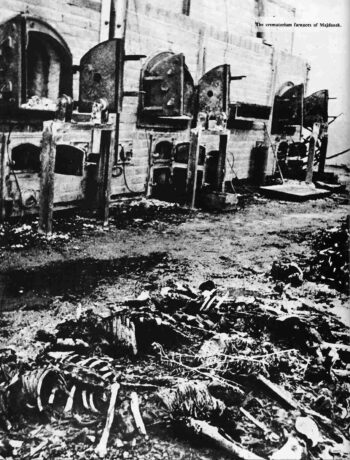
The Majdanek Camp was overrun by the Red Army in late August 1944. The crematorium building itself was burned down around that time, but the furnaces themselves survived largely unscathed. Images of the cremation furnaces with partially cremated corpses – probably a staged scene, see illustration – were used to create a horrific impression in Allied mass-media reports. It was meant to lend credibility to the Soviet propaganda lie that up to two million inmates had been slaughtered and cremated in the Majdanek Camp. This abuse of images of a cremation device for the purpose of atrocity propaganda was probably the reason why the German authorities ordered that the Auschwitz crematoria be dismantled in late 1944 before the arrival of Soviet troops. (See the section on Auschwitz.)
Buchenwald
The Buchenwald Camp was equipped with two coke-fired triple-muffle furnaces of the company Topf & Sons, Erfurt, one of which had been adapted for optional use with oil. The other one was structurally identical to the furnaces installed in Crematoria II and III at Auschwitz-Birkenau. Since the Birkenau devices have been dismantled and destroyed, the Buchenwald cremation devices are important for the study of Auschwitz regarding capacity and fuel consumption. No outrageous cremation claims of note were made regarding the Buchenwald Camp’s crematorium. (See Mattogno/Deana, Part 1, pp. 232f., 266-270.)
Mauthausen
The Mauthausen Camp was equipped with one coke-fired double-muffle furnace of the company Topf & Sons, Erfurt, which is identical to the three furnaces erected inside the crematorium (“Crema I”) at the Auschwitz Main Camp. The Mauthausen furnace was erected only in early 1945 and was hardly used. To this day it is in an excellent state of preservation. This allows them to be studied in detail, since the equivalent devices in Auschwitz were dismantled in 1944, and two of them were reassembled in a crude and flawed manner after the war by the Polish Auschwitz Museum, rendering them useless as objects of a technical study. (See Mattogno/Deana, Part 1, pp. 251-266.)
Gusen
The Gusen Camp, a satellite camp of the Mauthausen Camp, was equipped with one double-muffle coke-fired furnace of the company Topf & Sons, Erfurt. It has some structural differences compared to the three similar furnaces installed inside the crematorium at the Auschwitz Main Camp, making it superior to the Auschwitz devices. For instance, the gaps of the muffles’ fire-clay grate were much larger than those of the Auschwitz furnaces (eight openings of some 30 cm × 25 cm in size in Gusen, compared to six slits of just 5 cm width in Auschwitz), so that large corpse parts could fall into the post-combustion chamber beneath the muffle, clearing the muffle faster for a new load (although adding a new corpse while parts of the old load were still burning in the post-combustion chamber would have been illegal, strictly speaking). Furthermore, the Gusen furnace had one dedicated forced-draft system, whereas at Auschwitz, the same type of system was handling the flue gases of three furnaces; the Auschwitz forced-draft system was completely removed in the summer of 1942. (A forced-draft system increases the chimney draft, thus accelerating the burning of coke, hence generates more heat, which results in faster cremations).
Detailed documentation of the time and amount of coke it took to cremate a body has been preserved for the Gusen furnace. According to this, the average main-combustion phase of a single-corpse cremation took about 40 minutes and consumed some 30 kg of coke during continuous operation, and up to 48 kg/corpse during discontinuous operation (the difference is required to bring a cold furnace up to operating temperature). This allows for a realistic estimate of cremation times and coke consumption for similar devices, such as those installed at Majdanek and Auschwitz. (See Mattogno/Deana, Part 1, pp. 301-306, 311-314.)
Westerbork
The Westerbork transit camp in the Netherlands originally had an oil-fired cremation furnace of the Kori Company that was later refitted with a coke hearth. The camp’s archives contain numerous cremation lists giving the number of corpses cremated, the duration of each cremation, and the total coke consumption. The average cremation duration of that furnace, which had a larger hearth than the Auschwitz furnaces and thus a larger heat output, was about 50 minutes per corpse. This allows for a realistic estimate of cremation times and coke consumption for similar devices, such as those installed at Majdanek and Auschwitz. (See Mattogno/Deana, Part 1, pp. 306-314.)
Auschwitz Main Camp
 “Reconstructed” Crematorium I at the Auschwitz Main Camp during the 1990s. (Click on image to enlarge.)
“Reconstructed” Crematorium I at the Auschwitz Main Camp during the 1990s. (Click on image to enlarge.)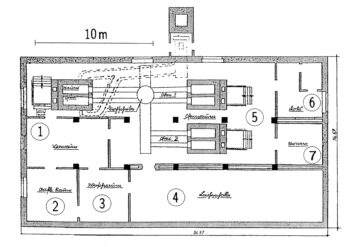 Floor plan of Crematorium I in Auschwitz I/Main Camp in its condition as of April 1942. The morgue (“Leichenhalle”) is at that time said to have been equipped for usage as a homicidal gas chamber. (Click on image to enlarge.)
Floor plan of Crematorium I in Auschwitz I/Main Camp in its condition as of April 1942. The morgue (“Leichenhalle”) is at that time said to have been equipped for usage as a homicidal gas chamber. (Click on image to enlarge.)1: Vestibule; 2: laying-out room; 3: washroom; 4: morgue; 5: furnace room; 6: coke; 7: urns.
Step by step, three coke-fired double-muffle cremation furnaces manufactured by the company Topf & Sons were set up in a building that had once served as an ammunition bunker for a Polish artillery unit. This building was subsequently called Crematorium I or later, when the Birkenau crematoria became operational, simply “the old crematorium.” It operated as such until 17 July 1943, when it was permanently shut down. See the data for each furnace in the table. Note that days in existence does not equal days in operation, as the first two furnaces had to be shut down and repaired several times during their existence. After the crematorium was retired, the furnaces were dismantled, and its parts stored. At that time, the chimney was also torn down.
| Furnace No. | Date Operational | Days in Existence |
|---|---|---|
|
1 |
15 Aug. 1940 |
1066 days |
|
2 |
22 Feb. 1941 |
511 days |
|
3 |
31 March 1942 |
473 days |
In mid-May 1942, damage to the crematorium chimney and later also to the flue ducts was discovered. Hence, the crematorium had to be shut down completely in early June in order to build a new chimney and new smoke ducts. This work was finished on August 8. During the months June to August 1942, the typhus epidemic that had been lingering in the Auschwitz and Birkenau camps for months went completely out of control, causing hundreds of victims every day. This happened at a time when the camp had absolutely no cremation capacity. Hence, when the new chimney was completed, cremations were restarted at a furious pace, damaging the new, still wet chimney right away.
In the fall of 1944, this building was re-purposed to serve as an air-raid shelter for SS men of the nearby SS hospital. Among other things, a sheet-metal-clad door was added allowing access from the outside directly to the former morgue, then subdivided into several air-raid shelter rooms.
The changes made for that purpose were only partially undone by the Auschwitz Museum after the war, thus creating a confusing hybrid exhibit – shown to hundreds of thousands of tourists every year – displaying some features of the original crematorium, some features of the later air-raid shelter, and some that were invented from scratch by the Museum, such as the Zyklon-B introduction shafts. Two of the three furnaces were also rebuilt using recovered original parts, although that reconstruction is highly flawed. For instance, the Museum did not add the coke hearth to the rear of the furnace, but built a small hearth underneath the muffle. A new chimney was also erected, although it is not connected to the former furnaces’ smoke ducts. (See the entry on Auschwitz Main Camp, as well as Mattogno/Deana, Part 1, pp. 212-228; Mattogno 2016c.)
As late as the year 2000, the Auschwitz Museum lied to its millions of visitors by claiming that what they see is identical to the original state of the crematorium, including its alleged homicidal gas chamber. Then they changed their narrative, admitting some inaccuracies that happened during the “reconstruction” after the war, but they keep lying about several aspects of their mendacious post-war tampering with this important piece of evidence, in particular about their post-war fabricated Zyklon-B introduction shafts. (See Mattogno 2016c; 2020, pp. 7-38.)
Auschwitz-Birkenau
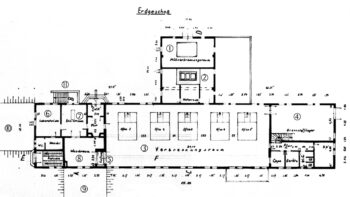 Ground floor plan of Crematorium II at Auschwitz-Birkenau; drawing no. 2197(p)I of March 20, 1943, by the Auschwitz Construction Office. Numbers here added: 1 Garbage incineration room; 2 chimney with three flues; 3 cremation room with five triple-muffle furnaces; 4 fuel storage room; 5 small freight elevator, only access to basement morgues from within the building; 6 laboratory; 7 dissecting room; 8 wash room; 9 semi-underground Morgue #1 (alleged homicidal gas chamber); 10 semi-underground Morgue #2 (alleged undressing room); 11 is an additional staircase to the underground area added later (not shown in the next, older illustration). (Click on image to enlarge.)
Ground floor plan of Crematorium II at Auschwitz-Birkenau; drawing no. 2197(p)I of March 20, 1943, by the Auschwitz Construction Office. Numbers here added: 1 Garbage incineration room; 2 chimney with three flues; 3 cremation room with five triple-muffle furnaces; 4 fuel storage room; 5 small freight elevator, only access to basement morgues from within the building; 6 laboratory; 7 dissecting room; 8 wash room; 9 semi-underground Morgue #1 (alleged homicidal gas chamber); 10 semi-underground Morgue #2 (alleged undressing room); 11 is an additional staircase to the underground area added later (not shown in the next, older illustration). (Click on image to enlarge.)When plans were initiated for the construction of a huge PoW camp near the village of Birkenau, close to Auschwitz, a new, larger crematorium was planned as well, although it was initially planned to be constructed at the Auschwitz Main Camp. It was to be equipped with five coke-fired triple-muffle furnaces manufactured by the company Topf & Sons. By early 1942, the construction site had been moved to the Birkenau Camp. But when the typhus epidemic in Auschwitz got out of control in the summer of 1942, a second crematorium of the same design (but mirror-image) was added (the later Crematorium III), then two further crematoria of a simplified design were added (the later Crematoria IV and V). The table below shows some features of these crematoria. (For this and many of the following data, see Mattogno/Deana, Part 1, pp. 228-251, 350f.)
| # | Startup 1943 | Shutdown | Furnaces | 20-h Capacity | Coke per Corpse* | 20-h coke* |
|---|---|---|---|---|---|---|
|
II |
14 March |
Oct. 1944 |
5×3-muffle |
300 corpses |
20 kg |
6,000 kg |
|
III |
25 June |
Oct. 1944 |
5×3-muffle |
300 corpses |
20 kg |
6,000 kg |
|
IV |
22 March |
Oct. 1944 |
1×8-muffle |
160 corpses |
15 kg |
2,400 kg |
|
V |
4 April |
Jan. 1945 |
1×8-muffle |
160 corpses |
15 kg |
2,400 kg |
| * for continuous operation; that value increases with increasing phases of furnace inactivity, up to twice that value and more. | ||||||
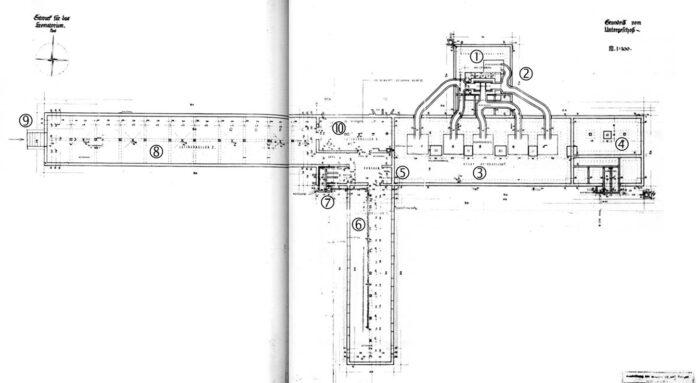
Basement floor plan of Crematorium II at Auschwitz-Birkenau; drawing no. 932 of January 23, 1942, by the Auschwitz Construction Office. Numbers here added: 1 Garbage incineration room; 2 chimney fed by six flues: five from the cremation furnaces and one from the waste incinerator; two flues merge together into one chimney flue; 3 cremation room with five triple-muffle furnaces; 4 fuel storage room; 5 small freight elevator, only access to basement morgues from within the building; 6 semi-underground Morgue #1, 7 m × 30 m (alleged homicidal gas chamber); 7 staircase from outside to the basement area; 8 semi-underground Morgue #2, 8 m × 50 m (alleged undressing room); 9 staircase from outside into Morgue #2; 10 Morgue #3, later subdivided into several rooms and equipped with a separate entry staircase from outside (see 11 in previous illustration). (Click on image to enlarge.)
The triple-muffle furnaces basically consisted of a double-muffle furnace with a third muffle inserted in the middle. The lateral muffles’ combustion gases flowed through openings in the side wall into the center muffle, from whose rear end they flowed into the smoke duct. Hence, the center muffle was not equipped with a hearth, but rather used the heat contained in the lateral muffles’ combustion gas to incinerate its load. Accordingly, the coke consumption of this furnace type was roughly 2/3 that of the double-muffle furnace (some 20 kg/corpse rather than 30 kg/corpse), while the cremation time was somewhat longer because none of the Birkenau crematoria had any forced-draft devices to fan the hearth flames. The triple-muffle furnace’s design was problematic, however, since twice as much combustion gas flowed through the center muffle as through each of the lateral ones, resulting in the gas flowing at twice the speed through the center muffle. That led to some of the combustion taking place in the smoke duct rather than the muffle, overheating and thus damaging the duct lining.
Hence, when Crematorium II was hastily put into operation in March 1943 due to a backlog of typhus victims in need of cremation, parts of the smoke ducts collapsed after only a few weeks, and the chimney lining was also damaged. This facility therefore operated at reduced capacity from early April 1943, and had to be shut down completely from mid-May until the end of August 1943 to rebuild the duct and chimney linings.
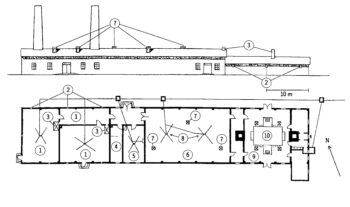 North lateral view (above) and floorplan (below) of Crematorium IV at Auschwitz-Birkenau (Crematorium V was its mirror image), based upon drawing no. 2036 of the Auschwitz Construction Office of Jan. 11, 1943. Numbers here added: 1 Three annex rooms; one was probably merely a hallway, another a shower room, and the third was temporarily planned to serve as a disinfestation room; these three rooms (or sometimes only the two large ones) are said to have been homicidal gas chambers, but since there was no ventilation system installed, this was impossible; 2 alleged Zyklon-B introduction hatches; since a metal grid was installed in those openings, they could not have served that purpose; 3 heating furnace, fueled from the hallway; 4 fuel storage room; 5 doctor’s office; 6 morgue; 7 ventilation chimneys (note: the alleged homicidal gas chambers had no ventilation chimneys!); 8 drains (also in the doctor’s office and the two large annex rooms); 9 cremation room; 10 four double-muffle furnaces are grouped into one large 8-muffle unit (Pressac 1989, p. 401).
North lateral view (above) and floorplan (below) of Crematorium IV at Auschwitz-Birkenau (Crematorium V was its mirror image), based upon drawing no. 2036 of the Auschwitz Construction Office of Jan. 11, 1943. Numbers here added: 1 Three annex rooms; one was probably merely a hallway, another a shower room, and the third was temporarily planned to serve as a disinfestation room; these three rooms (or sometimes only the two large ones) are said to have been homicidal gas chambers, but since there was no ventilation system installed, this was impossible; 2 alleged Zyklon-B introduction hatches; since a metal grid was installed in those openings, they could not have served that purpose; 3 heating furnace, fueled from the hallway; 4 fuel storage room; 5 doctor’s office; 6 morgue; 7 ventilation chimneys (note: the alleged homicidal gas chambers had no ventilation chimneys!); 8 drains (also in the doctor’s office and the two large annex rooms); 9 cremation room; 10 four double-muffle furnaces are grouped into one large 8-muffle unit (Pressac 1989, p. 401).Crematorium IV fared even worse. Its furnaces and chimney were barely operational when incinerations began at a frantic pace. Since the fresh mortar and brickwork still contained much water, the resulting fast evaporation of this water damaged furnaces, ducts and chimneys to such a degree that the entire facility became unusable within two months. The facility was never fully repaired afterwards and was abandoned as a cremation facility.
The coke-fired eight-muffle furnaces of Crematoria IV and V, also manufactured by the company Topf & Sons, consisted of a single-muffle furnace with an additional muffle attached to its side. The combustion gases of the first muffle were used to heat and incinerate the load of the second muffle. As a result, this furnace used roughly half the fuel per corpse compared to the double-muffle furnace, hence some 15 kg/corpse. Four of these furnaces were assembled to form a large block (two side-by-side, and two of these assemblies back-to-back), thus reducing heat losses due to convection and radiation.
In October 1941, the Birkenau Camp was planned to hold some 125,000 PoWs. In August of 1942, that planned number rose to 200,000 inmates. To this figure, we need to add the inmates held in the Auschwitz Main Camp and the various satellite camps. The project was huge and unparalleled. Initially, only 15 muffles (of Crematorium II) were planned, but by August 1942, with the camp’s mortality reaching a catastrophic peak of some 8,600 victims per month, mainly of the raging typhus epidemic, the planned cremation capacity was increased from 15 to 46 muffles – hence 31 additional muffles. This may look excessive, but if we compare this with the ratio of monthly mortality to cremation muffles in other camps for which no one today claims any mass-extermination activities, the Auschwitz plans are not excessive at all; see the following table (cf. Rudolf/Mattogno 2017, pp. 164-171).
| Dachau | Buchenwald | Auschwitz | |
|---|---|---|---|
|
mortality during additional-furnace planning month: |
66 |
337 |
8,600 (Aug. 1942) |
|
planned number of additional muffles: |
4 |
6 |
31* |
|
ratio muffles/mortality: |
6% |
2.8% |
0.4% |
| * 15 muffles in the future Crematorium III, and 16 muffles together in Crematoria IV and V | |||
This clearly shows that the construction of four crematoria was dictated not by plans of mass extermination but rather by the catastrophic situation created by rampaging epidemics, combined with plans to massively increase the camp population.
By comparison: The distance a car can drive in its lifetime cannot be determined by multiplying its top speed by the hours contained in its lifespan of, say, ten years. At a top speed of 120 mph and a planned lifetime of ten years, this would amount to more than ten million miles. A car cannot be operated at top speed round the clock for years on end, and neither can a cremation furnace. Hence, multiplying the number of muffles with the daily number of cremations possible at peak performance, multiplied with the days a facility existed, is deceitful at best.
| Month | coke [t] | Month | coke [t] |
|---|---|---|---|
|
January |
23 |
June |
61 |
|
February |
40 |
July |
67 |
|
March |
144.5 |
August |
71 |
|
April |
60 |
September |
61 |
|
May |
95 |
October |
82 |
|
Total: |
704.5 |
||
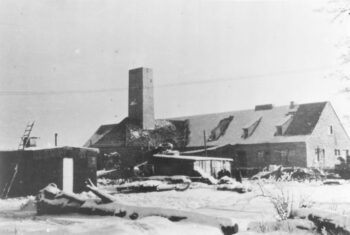 The almost finished Crematorium II.
The almost finished Crematorium II.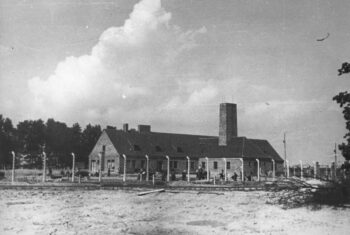 The finished Crematorium III.
The finished Crematorium III.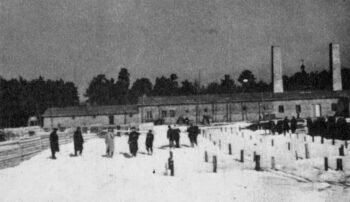 The finished Crematorium IV.
The finished Crematorium IV.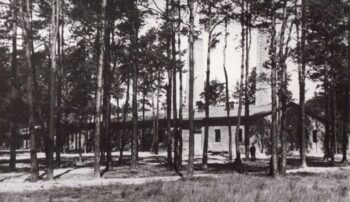 The finished Crematorium V.
The finished Crematorium V.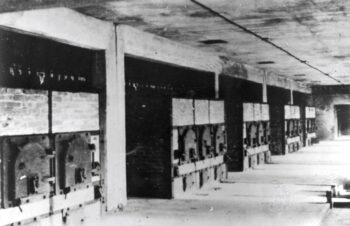 The five triple-muffle furnaces of Crematorium II.
The five triple-muffle furnaces of Crematorium II.The intensity at which the crematoria in Auschwitz and Birkenau were used can be gleaned from the coke deliveries to these facilities. Almost complete records of them have been preserved from early 1942 until October 1943; see the table to the right.
When considering all factors involved, such as the various furnace types operating at various times with various capacities, and the type of corpses requiring different amounts of fuel (emaciated victims of epidemics, low in body fat, require more fuel), the results show that the coke deliveries are fully compatible with the number of deaths recorded in the camp’s documents, mainly due to the raging epidemics. The resulting average coke consumption per cremated body is furthermore quite similar to that at the Gusen Camp, for which detailed documentation on cremation activities has been preserved.
On the other hand, if the alleged but undocumented number of gassing victims are added to the documented deaths, the coke available for cremating each corpse would drop to an impossibly low amount of just some 2 to 3 kg. (See Mattogno 2019, pp. 272-275; 2021a, pp. 30-35.)
The vast documentation of the Birkenau crematoria includes many documents about repairs, but it does not include any trace of the muffle linings and refractory grates being completely replaced. These had a lifetime of about 2,000 cremations. This sets the maximum number of cremations to (46 muffles × 2,000 =) 92,000 for the Birkenau crematoria (see Mattogno/Deana, Part 1, pp. 348-350). Adding to this the maximum possible number of cremations performed in the old crematorium (6 muffles × 2,000 = 12,000), and the number of victims initially buried but then exhumed and cremated outdoors during open-air incineration (some ten to twenty thousand), this is in good agreement with the total number of actual victims of the Auschwitz camp complex – around 135,500 (see Mattogno 2023, Part 2, p. 211) – without the claimed one million gas-chamber victims, for whom there was no cremation capacity left at all.
Starting in late fall of 1944, in anticipation of a Soviet conquest of the area, the camp authorities started demolishing Crematoria II through IV. Crematorium V was dynamited only during the final days of the SS’s presence at Auschwitz. This evidently was done to prevent the Soviets from staging atrocity photos, as they had done at the Majdanek Camp (Mattogno 2023, Part 1, pp. 481f.).
Dachau
The Dachau Camp initially had a mobile oil-fired double-muffle cremation furnace of the Topf Company, re-equipped (and immobilized) with two coke hearths, one on either side. The device was intensely used, showing clear signs of wear. It is located in a small building and can be inspected there to this day (see illustrations in Mattogno/Deana, Part 2, pp. 43-50). Two coke-fired double-muffle furnaces of the Kori firm were later built in the new crematorium building, showing little sign of usage. (For a description, read Mattogno/Deana, Part 1, pp. 391f.)
Simultaneous Cremation of Multiple Bodies
In civilian crematoria, multiple cremations in the same muffle were prohibited by law and were never carried out. The furnaces set up in German wartime camps were built following civilian laws and regulations, so they, too, were designed to cremate only one body at a time. In fact, most furnaces set up in the camps were cheaper, trimmed-down versions. For one thing, their doors and muffles were usually smaller than civilian ones, because the latter had to allow the occasional introduction of large coffins, while the camp furnaces either used only small caskets or none at all. This is particularly true for the furnaces of the companies Topf and Kori, the most-frequent camp furnaces.
The Topf furnace’s doors were 60 cm (2 ft) wide and high. The lower approximately 10 cm of that height were taken up by the corpse-introduction stretcher resting on a pair of rollers, while the upper 30 cm consisted of a semi-circular arch. With human corpses being some 50 cm wide and 20 to 25 cm high, it was physically possible to enter two corpses stacked on top of each other through that door, but certainly not more. Once two corpses had been deposited on the muffle grate, introducing another set of two corpses, as for instance claimed by Henryk Tauber, would have required tipping the 45-cm-wide stretcher steeply upward to get it on top of the two corpses already in that muffle. Trying this would have made the corpses lying on the stretcher hit the muffle vault. There would have been no way of pushing the stretcher all the way into the muffle. Furthermore, with such an inclination, the two corpses lying on the stretcher might have slid backwards and off the stretcher.
In most camps, Auschwitz and Birkenau included, inmate bodies were cremated without a coffin. As a result, the muffle temperature dropped drastically when introducing a body, because the initial phase of evaporating the bodies’ water requires a lot of heat. The coke hearth and the muffle wall’s refractory material were designed to store only the heat needed to cope with one body’s amount of water. Placing several bodies at once into such a furnace with several times the amount of water would have dropped the muffle temperature below the operational optimum. This would have slowed down the cremation process drastically. With many corpses in a muffle, the temperature would have dropped to a point where no cremation but only “charcoaling” would have occurred.
Placing several corpses at once into a muffle not designed for it leads to another problem: openings in the muffle grate and the side walls, through which the combustion gases travel, get obstructed, slowing down the evaporation phase even more.
However, once the water has evaporated and the bodies burn, the amount of heat produced would overwhelm the muffle walls’ ability to store such heat, and the amount of combustion gasses developing would speed up the flow of overheated gases into the smoke ducts, which eventually suffer heat damage.
In other words, burning several corpses at once in a muffle designed for only one body would not have sped up the cremation process but might have initially led to an almost standstill, while the latter combustion phase would have been so intense that the refractory lining of the muffles and smoke ducts would have been seriously damaged in the long run.
(For details, see Mattogno/Deana, Part 1, pages 317-327.)

You need to be a registered user, logged into your account, and your comment must comply with our Acceptable Use Policy, for your comment to get published. (Click here to log in or register.)